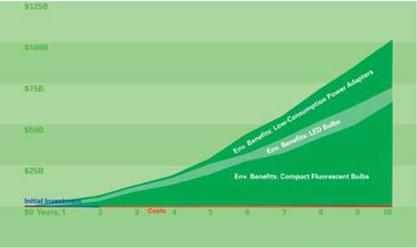 |
 |
Social Return on Investment (SROI) strategies attempt to measure social-economic impacts like LCAs measure environmental impacts (see Figure 3.14). This is a very new approach, and there are no still no standards or agreement about how best to do this. It also suffers the challenge of which social issues to measure, since any list will likely be different for each individual or group.
Strengths: Describes an approach to valuing social issues within a financial framework. Open to interpreting approach for specific conditions.
Weaknesses: Controversy over defining of social value in financial terms. No set template for developers to follow. Subjective.
However, progress is being made. Socially Responsible Investment Funds (SRIs), for example, use proprietary metrics to measure the social performance of the companies they invest in and “screens” to bar investments unmatched with their values. All of them publish the list of companies they invest in and some publish their metrics, but there is little agreement in approach or values.
Generating a Social Return on Investment (SROI) assessment is not a trivial undertaking, because it requires the translation of social values into some type of monetary return. Considerable controversy surrounds the notion that values such as tolerance and anti-discrimination can be translated into monetary terms easily or at all. Some argue that it would be wrong to even attempt to monetize core human values, as they fear that inappropriate tradeoffs will result. For example, is a little slavery all right if the bottom line improves?
There are several different approaches to calculating SROI, but one of the most well known is the Social Impact Assessment used as part of the Haas Global Social Venture Competition, orchestrated by Haas Business School at UC Berkeley. This structure has evolved into a framework, templates, and cases that describe how some social ventures are attempting to value the social component of their business’ impact. SROI can be calculated for any organization, non-profit and for-profit alike, at www. gsvc. org.
To start with, it’s important to establish and describe the impact value chain across the social issue spectrum. These track the inputs (benefits) of the solutions, the activities that create the impact, the outputs (value being generated in social terms), and the overall outcome of the organization’s impact. To be sure, it’s not possible to calculate all social impacts, and it can
be controversial how an organization makes its assumptions and calculations. More so, it may not be appropriate to even try to quantify social impact for some cases (such as trying to justify freedom over slavery—there shouldn’t need to be a quantification).
SRQ! of Reveal Sustainability Labeling Initiative
The Reveal system is the result of several years of my work and my thesis at business school. It is a rating and labeling system for use with products and services in order to help customers make more informed choices at the points of decisions and purchase. More on the solution itself in Chapter 17. When I was preparing the business plan, in order to describe the SROI, I used the process outlined by the Global Social Venture Competition (which we entered) and had to find a way to reasonably measure the impacts such buying decisions had in economic terms.
To be conservative, I chose to look at only three products: LED light bulbs, compact fluorescent light bulbs, and low-consumption power
SROI of Reveal Sustainability Labeling Initiative (continued)
adapters. By no means would this represent the total buying power of consumers making choices for more sustainable products, but it was a simple example.
I measured the economic impact for reducing only carbon dioxide and sulfur dioxide in the environment (see Figure 3.15). For sure, there would be many other positive effects for these products. I valued these at the current price in the Chicago Climate Exchange (CCX) trading markets and made as conservative assumptions
|
Inputs ■Екіайіи C5R data * New CSR data * New LCA data |
Activities •EatabhBfo імііївд, standards, and templates *Make rating» available * Promote faUnfts |
Qupure •Consumer purchases aligned with C5R performance |
Outcomes * Financial rewards for benar env. and social performance * Reduced negative CSR impacts |
Gobi Alignment •Connecta CSR performance with linancial rewards |
|
Inputs * Consumer prefarrmcn dn1a Ibassri on customisation) |
Activities * Compile market mm arch on consumer preferences |
Ouputs • Market research on consumer preferences nodi buying behavior |
Outcomes * Improved carp, performance * Increased arg, effectiveness |
Goal Alignment * Connects CSR performance wi"1h financial rewards |
|
* Consumer I. NGOs Si govs.) purchasing data * Increased market efficiency * Increased brand value |
FIGURE 3.15. http://www. flickr. com/photos/rosenfeldmedia/3276761038 Factors for measuring the economic impact.
SROI of Reveal Sustainability Labeling Initiative (continued)
as I could about customer adoption (5 percent adoption in the beginning, growing to 80 percent in 10 years, from only the most environmentally – oriented 17 percent of the U. S. and EU populations). I also assumed that customers would only replace three CFL bulbs, one LED bulb, and one low-consumption power adapter per year. These simple purchases would result in over $100B of benefits over 10 years (see Figure 3.16). Now, imagine what would happen if more
|
FIGURE 3.16. http://www. flickr. com/photos/rosenfeldmedia/3261629246 The savings and benefits are obvious. |
SROI of Reveal Sustainability Labeling Initiative (continued)
than merely one percent of the U. S. and EU populations replaced three bulbs and one power adapter every year. Or imagine the gains that all of their other purchases would create if they made more sustainable choices.
www. revealinfo. com




